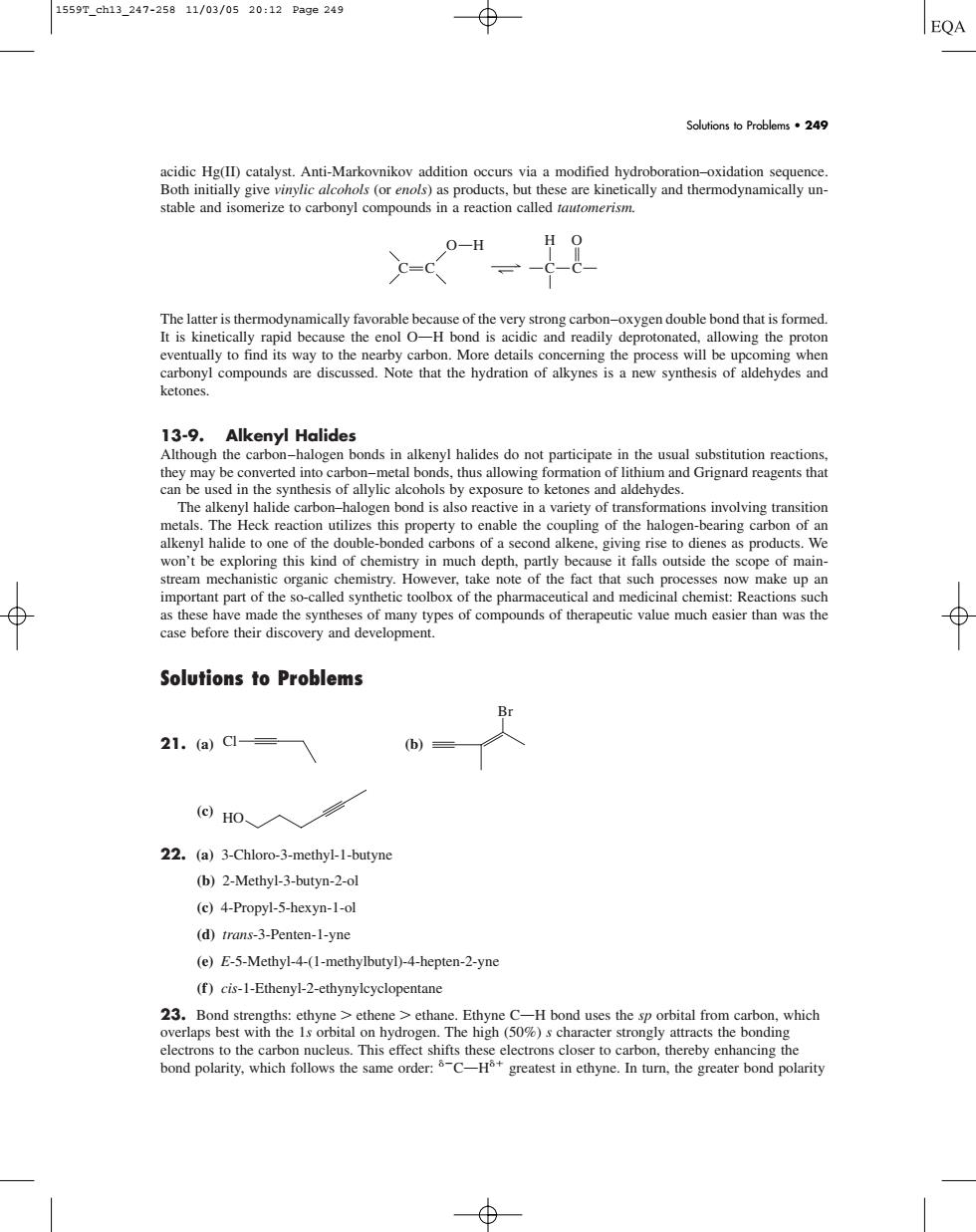正在加载图片...

15597.ch13247-25811/03/0520:12Pag0249 EQA Solutions to Problems249 stable and isomerize to carbonyl compounds in a reaction calledmr -c0- eropey compounds are discussed.Note that the hydration of alkynes is a new synthesis of aldehydes and 13-9.Alkenyl Halides ed in ynt sis of allylic alcohols by exposure to ketones and aldehydes. e ca s invo alkenyl halide to one of the double-bonded carbons of a second alkene.givi rise to diene as products.We won'tbe this kind of chemist y in muc cau eit falls outside the scope of main o the the pharmaceutical and medicinal chemist:Reactions such Solutions to Problems Br 21.(a)C1= (b)= 22.(a)3-Chloro-3-methyl-1-butyne (b)2-Methyl-3-butyn-2-ol (c)4-Propyl-5-hexyn-1-ol (d)trans-3-Penten-1-yne (e)E-5-Methyl-4-(1-methylbutyI)-4-hepten-2-yne (f)cis-1-Ethenyl-2-ethynylcyclopentane 23.Bond strengths:ethyne>ethene>ethane.Ethyne C-H bond uses the sp orbital from carbon,which overlaps best withacidic Hg(II) catalyst. Anti-Markovnikov addition occurs via a modified hydroboration–oxidation sequence. Both initially give vinylic alcohols (or enols) as products, but these are kinetically and thermodynamically unstable and isomerize to carbonyl compounds in a reaction called tautomerism. The latter is thermodynamically favorable because of the very strong carbon–oxygen double bond that is formed. It is kinetically rapid because the enol OOH bond is acidic and readily deprotonated, allowing the proton eventually to find its way to the nearby carbon. More details concerning the process will be upcoming when carbonyl compounds are discussed. Note that the hydration of alkynes is a new synthesis of aldehydes and ketones. 13-9. Alkenyl Halides Although the carbon–halogen bonds in alkenyl halides do not participate in the usual substitution reactions, they may be converted into carbon–metal bonds, thus allowing formation of lithium and Grignard reagents that can be used in the synthesis of allylic alcohols by exposure to ketones and aldehydes. The alkenyl halide carbon–halogen bond is also reactive in a variety of transformations involving transition metals. The Heck reaction utilizes this property to enable the coupling of the halogen-bearing carbon of an alkenyl halide to one of the double-bonded carbons of a second alkene, giving rise to dienes as products. We won’t be exploring this kind of chemistry in much depth, partly because it falls outside the scope of mainstream mechanistic organic chemistry. However, take note of the fact that such processes now make up an important part of the so-called synthetic toolbox of the pharmaceutical and medicinal chemist: Reactions such as these have made the syntheses of many types of compounds of therapeutic value much easier than was the case before their discovery and development. Solutions to Problems 21. (a) (b) (c) 22. (a) 3-Chloro-3-methyl-1-butyne (b) 2-Methyl-3-butyn-2-ol (c) 4-Propyl-5-hexyn-1-ol (d) trans-3-Penten-1-yne (e) E-5-Methyl-4-(1-methylbutyl)-4-hepten-2-yne (f) cis-1-Ethenyl-2-ethynylcyclopentane 23. Bond strengths: ethyne ethene ethane. Ethyne COH bond uses the sp orbital from carbon, which overlaps best with the 1s orbital on hydrogen. The high (50%) s character strongly attracts the bonding electrons to the carbon nucleus. This effect shifts these electrons closer to carbon, thereby enhancing the bond polarity, which follows the same order: COH greatest in ethyne. In turn, the greater bond polarity HO Br Cl O H C C H O C C Solutions to Problems • 249 1559T_ch13_247-258 11/03/05 20:12 Page 249���